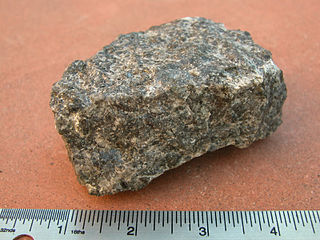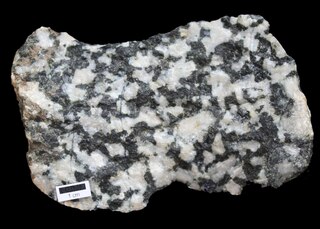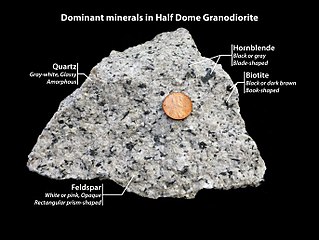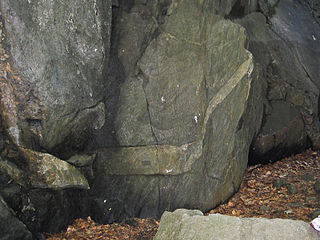
Gabbro is a phaneritic (coarse-grained), mafic intrusive igneous rock formed from the slow cooling of magnesium-rich and iron-rich magma into a holocrystalline mass deep beneath the Earth's surface. Slow-cooling, coarse-grained gabbro is chemically equivalent to rapid-cooling, fine-grained basalt. Much of the Earth's oceanic crust is made of gabbro, formed at mid-ocean ridges. Gabbro is also found as plutons associated with continental volcanism. Due to its variant nature, the term gabbro may be applied loosely to a wide range of intrusive rocks, many of which are merely "gabbroic". By rough analogy, gabbro is to basalt as granite is to rhyolite.

Diorite is an intrusive igneous rock formed by the slow cooling underground of magma that has a moderate content of silica and a relatively low content of alkali metals. It is intermediate in composition between low-silica (mafic) gabbro and high-silica (felsic) granite.

Intrusive rock is formed when magma penetrates existing rock, crystallizes, and solidifies underground to form intrusions, such as batholiths, dikes, sills, laccoliths, and volcanic necks.

Lamprophyres are uncommon, small-volume ultrapotassic igneous rocks primarily occurring as dikes, lopoliths, laccoliths, stocks, and small intrusions. They are alkaline silica-undersaturated mafic or ultramafic rocks with high magnesium oxide, >3% potassium oxide, high sodium oxide, and high nickel and chromium.

Granodiorite is a coarse-grained (phaneritic) intrusive igneous rock similar to granite, but containing more plagioclase feldspar than orthoclase feldspar.
The calc-alkaline magma series is one of two main subdivisions of the subalkaline magma series, the other subalkaline magma series being the tholeiitic series. A magma series is a series of compositions that describes the evolution of a mafic magma, which is high in magnesium and iron and produces basalt or gabbro, as it fractionally crystallizes to become a felsic magma, which is low in magnesium and iron and produces rhyolite or granite. Calc-alkaline rocks are rich in alkaline earths and alkali metals and make up a major part of the crust of the continents.

In geology, an igneous intrusion is a body of intrusive igneous rock that forms by crystallization of magma slowly cooling below the surface of the Earth. Intrusions have a wide variety of forms and compositions, illustrated by examples like the Palisades Sill of New York and New Jersey; the Henry Mountains of Utah; the Bushveld Igneous Complex of South Africa; Shiprock in New Mexico; the Ardnamurchan intrusion in Scotland; and the Sierra Nevada Batholith of California.

The Cathedral Peak Granodiorite (CPG) was named after its type locality, Cathedral Peak in Yosemite National Park, California. The granodiorite forms part of the Tuolumne Intrusive Suite, one of the four major intrusive suites within the Sierra Nevada. It has been assigned radiometric ages between 88 and 87 million years and therefore reached its cooling stage in the Coniacian.

Half Dome Granodiorite is granodiorite found in a region on and near Half Dome, in Yosemite National Park, California, United States. The granodiorite forms part of the Tuolumne Intrusive Suite, one of the four major intrusive suites within the Sierra Nevada.

El Capitan Granite is a type of granite, in a large area near El Capitan, in Yosemite National Park, California, United States. The granite forms part of the Tuolumne Intrusive Suite, one of the four major intrusive suites within the Sierra Nevada.
Dedham granite is a light grayish-pink to greenish-gray, equigranular to slightly porphyritic, variably altered, granite south and west of Boston, named for the town of Dedham, Massachusetts.

Sentinel granodiorite is a type of granodiorite found in Yosemite National Park. It is a poorly understood western "outlier" of the ~93-85-Ma Tuolumne Intrusive Suite of the Sierra Nevada batholith. It is only slightly older than the undated Yosemite Creek Granodiorite and the Kuna Crest Granodiorite.

An intrusive suite is a group of plutons related in time and space. All rocks in an intrusive suite result from the same magma-producing event.

The Tuolumne Intrusive Suite is the youngest and most extensive of the intrusive suites of Yosemite National Park, and also comprises about 1/3 of the park's area. The Suite includes Half Dome Granodiorite, Cathedral Peak Granite, and Kuna Crest Granodiorite.

The Intrusive Suite of Buena Vista Crest is an intrusive suite which extends 30 kilometres (19 mi) southward, from Yosemite Valley to Yosemite National Park's southeastern boundary, into plutons of the Sierra Nevada Batholith, which are slightly older. These intrusive suites also include
- Fine Gold Intrusive Suite
- Intrusive Suite of Jack Main Canyon
- Intrusive Suite of Merced Peak
- Intrusive Suite of Sonora Pass
- Intrusive Suite of Yosemite Valley
- Tuolumne Intrusive Suite

The Intrusive Suite of Sonora Pass is one of several intrusive suites in Yosemite National Park. These also include
- Fine Gold Intrusive Suite
- Intrusive Suite of Buena Vista Crest
- Intrusive Suite of Jack Main Canyon
- Intrusive Suite of Merced Peak
- Intrusive Suite of Yosemite Valley
- Tuolumne Intrusive Suite

Mammoth Peak is a mountain in the area of Tuolumne Meadows, Yosemite National Park, California. The summit is a class 1-2 cross-country hike that features river crossings and boulder scrambling. The peak lies at the northern end of the Kuna Crest and is close to California State Route 120. From the road, its summit appears rounded and quite rocky. Though Mammoth Peak is not as popular as other nearby peaks, its relatively easily accessed summit affords tremendous views of Mount Gibbs, Mount Dana, and Mount Lewis.

Kuna Crest is a mountain range near Tuolumne Meadows, in Yosemite National Park, California.
I-type granites are a category of granites originating from igneous sources, first proposed by Chappell and White (1974). They are recognized by a specific set of mineralogical, geochemical, textural, and isotopic characteristics that indicate, for example, magma hybridization in the deep crust. I-type granites are saturated in silica but undersaturated in aluminum; petrographic features are representative of the chemical composition of the initial magma. In contrast S-type granites are derived from partial melting of supracrustal or "sedimentary" source rocks.
Johnson Granite Porphyry is found in Tuolumne Meadows, Yosemite National Park.














